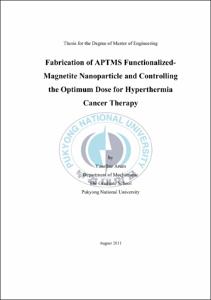Fabrication of APTMS Functionalized-Magnetite Nanoparticle and Controlling the Optimum Dose for Hyperthermia Cancer Therapy
- Alternative Title
- APTMS 기능화된 자기 나노입자의 제작과 온열 암 치료를 위한 최적화
- Abstract
- Magnetic hyperthermia has been used for many years to treat a variety of malignant tumors. One of the problems in magnetic hyperthermia is the choice of the correct particle concentration in order to achieve a defined temperature increase in the tumor tissue. Using the correct nanoparticle dosage and considering their specific loss power, it is possible to estimate the efficiency of this therapeutic method.
In this study, we synthesized (3-Aminopropyl)-trimethoxysilane (APTMS)-functionalized Fe3O4 MNPs and evaluated magnetic heat distribution induced by these particles in agar tissue phantom when it subjected to the AC magnetic filed. By varying the concentration of particles, we determined the optimum dose to achieve a defined temperature of 42oC or higher in the tumor tissue. The experimental data were compared with computer-based model, which was created using COMSOL Multiphysics to simulate the heat dissipation within the tissue for typical configurations of the tumor position as well as particle distribution within the tumor. In our findings, the simulation data were comparable to the actual experimental data and the heat dose of 19.9 W/gtissue was acceptable for 5 mm tumor. Further, the cell study using HeLa cancer cell demonstrated that heating the cancer cells up to 50oC for 10 min was sufficient for complete cell killing and cell viability assay showed that Fe3O4-APTMS MNPs exhibited no significant cytotoxicity against HeLa cells. Additionally, it was observed that the FITC-labeled Fe3O4-APTMS MNPs presented high cell biocompatibility and cellular uptake for efficient endocytosis.
- Issued Date
- 2011
- Awarded Date
- 2011. 8
- Type
- Dissertation
- Publisher
- Department of Mechatronic, Pukyong National University
- Affiliation
- Master Student in Department of Mechatronic, The Graduate School
- Department
- 대학원 메카트로닉스공학과
- Advisor
- Oh Junghwan
- Table Of Contents
- TABLE OF CONTENTS
LIST OF FIGURES iii
LIST OF TABLES v
ABSTRACT vi
CHAPTERS
1. Introduction 1
1.1 Motivation 5
1.2 Specific Aims of this Study 6
2. Background Theories 7
2.1 Special Features of Magnetic Nanoparticles 7
2.1.1 Finite-Size Effects 7
2.1.2 Surface Effects 10
2.2 Synthesis and Surface Modification of Magnetic Nanoparticles 11
2.3 Heating Magnetic Nanoparticles with Alternating Magnetic Field 14
2.3.1 Power Dissipation in Non-magnetic Nanoparticles 14
2.3.2 Power Dissipation in Magnetic Nanoparticles 16
2.3.3 Magnetic Hysteresis 19
2.4 Specific Absorption Rate (SAR) 21
3. Experimental Setup 24
3.1 Synthesis of Magnetic Nanoparticles 24
3.2 Characterization of nanoparticles 26
3.3 Magnetic Heating Experiment 26
3.4 Measurement of heating potential of Fe3O4-APTMS by SAR 27
3.5 Cell Culture 28
3.6 Cytotoxic Effect of Heat at Different Temperature 28
3.7 Cell Viability Assay using WST-1 28
3.8 Cell Labeling using FITC 29
3.9 Loss Power Density Evaluation 29
3.10 Computer-Based Model of Heat Transfer in Agar Tissues 31
3.11 Numerical Investigation 33
4. Results and Discussion 35
4.1 Fe3O4 MNPs Crystal Characterization 35
4.2 Surface Modification of Fe3O4 MNPs via Ligand Exchange 35
4.3 TEM Image Characterization 36
4.4 Magnetic Properties 38
4.5 Increase of Temperature on Agar Tissue Surface containing
Fe3O4-APTMS MNPs When Exposed to the Magnetic Field 39
4.6 Loss power density estimation and temperature prediction 40
4.7 Simulation of thermal gradient in vitro agar tissue phantom 42
4.8 Cytotoxic Effect of Heat 43
4.9 Evaluation of In vitro Cell Viability 44
4.10 Cellular uptake of FITC-labeled Fe3O4-APMTS 45
4.11 Discussion 45
5. Conclusion 49
6. References 50
- Degree
- Master
- Files in This Item:
-
-
Download
 Fabrication of APTMS Functionalized-Magnetite Nanoparticle and Controlling the Optimum Dose for Hype.pdf
기타 데이터 / 3.35 MB / Adobe PDF
Fabrication of APTMS Functionalized-Magnetite Nanoparticle and Controlling the Optimum Dose for Hype.pdf
기타 데이터 / 3.35 MB / Adobe PDF
-
Items in Repository are protected by copyright, with all rights reserved, unless otherwise indicated.